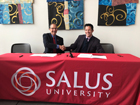
Salus University president Michael H. Mittelman, left, and Eyesafe CEO Justin Barrett signed an agreement Oct. 10 to partner in a research project about the health hazards and protective solutions related to blue light for the electronics display industry.
|